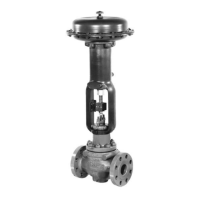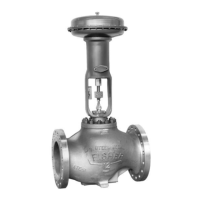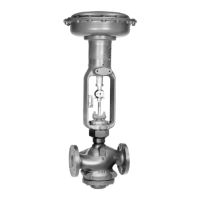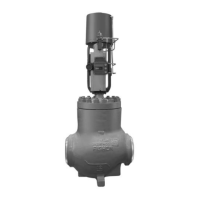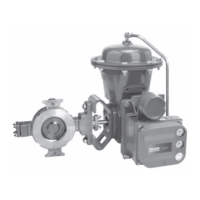Instruction Manual
D102010X012
EU and EW Series Valves
July 2017
12
18. For spring‐loaded PTFE V‐ring packing, tighten the packing flange nuts until the shoulder on the packing follower
(key 13, figure 4) contacts the bonnet.
For graphite packing, tighten the packing flange nuts to the maximum recommended torque shown in table 3. Then,
loosen the packing flange nuts and retighten them to the recommended minimum torque shown in table 3.
For other packing types, tighten the packing flange nuts alternately in small, equal increments until one of the nuts
reaches the minimum recommended torque shown in table 3. Then, tighten the remaining flange nut until the
packing flange (key 3, figure 4) is at a 90‐degree angle to the valve stem.
19. Mount the actuator on the valve assembly, and reconnect the actuator and valve stem according to the procedure
in the appropriate actuator instruction manual. Check for leakage around the packing follower when the valve is
being put into service. Retighten the packing flange nuts as required.
Trim Maintenance
Trim Removal
Except where indicated, key numbers in this section are shown in figure 5 for EUT‐2 and EWT‐2 valves and in figure 6
for EUD and EWD valves.
1. Isolate the control valve from the line pressure, release pressure from both sides of the valve body, and drain the
process media from both sides of the valve. If using a power actuator, also shut off all pressure lines to the power
actuator, release all pressure from the actuator, and use lock‐out procedures to prevent injury while you work on
the equipment.
2. Remove the actuator and the bonnet according to steps 2 through 5 of the Replacing Packing Section.
CAUTION
Use care to avoid damaging gasket surfaces.
The surface finish of the valve stem (key 7) is critical for making a good packing seal. The inside surface of the cage or cage
assembly (key 3) is critical for smooth operation of the valve plug and for making a seal with the seal ring (key 28). The
seating surfaces of the valve plug (key 2) and seat ring (key 9) are critical for proper shutoff. Assume all these parts are in
good condition, and protect them accordingly unless inspection reveals otherwise.
3. Packing parts can be removed if desired. Replace these parts as described in the Packing Replacement section.
4. Lift the valve plug and stem assembly out of the valve body and set it on a protective surface. If the valve plug is to
be reused, protect the valve plug seating surface to prevent scratches.
5. Install screws or bolts into the tapped holes in the top of the cage assembly (key 3), and carefully lift it out of the
valve body. Remove the gaskets (keys 10 and 11).
6. Proceed as appropriate:
For EUT‐2 or EWT‐2 valves (figure 5), the valve has a seat ring seal ring (key 6). Inspect this seal ring, and remove it if
replacement is necessary. The seat ring is screwed into the cage and secured with two tack welds, one on each side of
the cage. Remove the tack welds by grinding or filing them off.
D For all sizes except NPS 12 and 16x12, there are slots cut in the seat ring. Insert a bar through the slots and turn the
seat ring out of the cage.
D For NPS 12 and 16x12, there are two 3/8 inch UNC tapped holes in the bottom of the seat ring. Screw cap screws
into these holes. Use a bar to pry against the cap screws and turn the seat ring out of the cage.
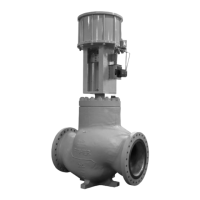
